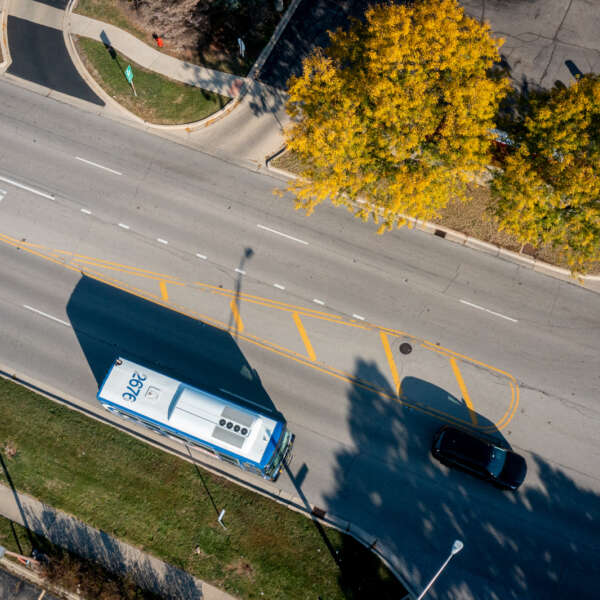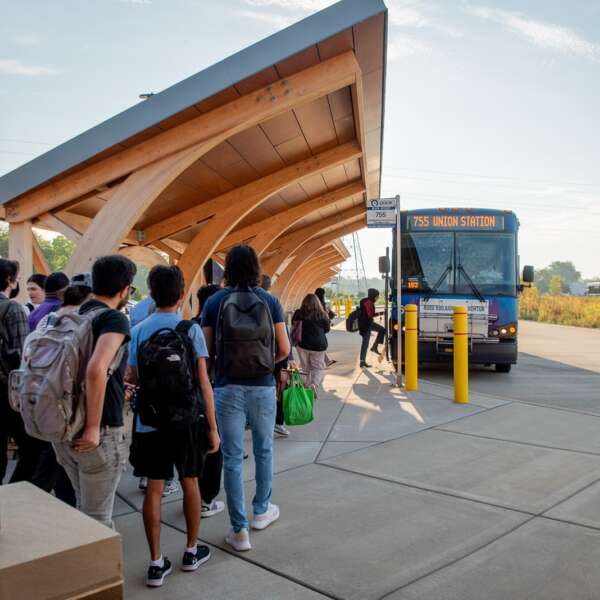Coalition members provide feedback on possible reforms to improve service and accountability for riders
August 5, 2024
August 5, 2024

More than 140 riders, agency staff, legislative staff, advocates, and other stakeholders met virtually on July 31 for the fifth quarterly Transit is the Answer Coalition meeting and discussed regional transit system updates, legislative developments, and proposed governance reform concepts.
After a welcome from RTA Executive Director Leanne Redden, the meeting began with a presentation from RTA Government Affairs Associate Kendra Johnson on system and legislative updates. She shared that the first half of 2024 brought significant ridership gains as CTA, Metra, and Pace are providing more than 1.2 million trips per weekday and adjusting their service to new travel patterns. And as ridership has increased, crime has decreased. In April, the system registered a 16 percent year over year decrease in crime.
Making paying for transit more seamless and affordable is one action item in Transit is the Answer, the RTA’s regional transit strategic plan. Johnson reported that there are new fare passes and products to incentivize more regional mobility, like the recently announced Regional Day Pass, and that the RTA has expanded the region’s reduced fare offerings with an income-based Access Pilot Program.
While the recent ridership growth is encouraging, it does not resolve the transit system’s financial crisis. As a result of chronic underfunding and the growth of remote and hybrid work post-pandemic, starting in 2026 the system faces a projected budget gap equivalent to 20 percent of the region’s operating budget, estimated at more than $730 million annually and growing. Increased funding is required to fill the gap and maintain service levels, while additional funds beyond the fiscal cliff can realize expanded and improved transit service.
“Right now, with federal relief funding filling the operations gap, the system is expanding service and seeing increased ridership, and in turn riders are experiencing all the benefits of these improvements,” Johnson said. “Seizing upon this momentum will result in a system that works better for everyone. Delaying action risks setting the system back, making our region less equitable, economically competitive, and in a worse position to combat climate change.”
The RTA is working with state lawmakers, advocates, and the Service Boards to develop sustainable funding solutions that improve the system for all riders and maximize transit’s impact on the region’s economy, climate, and equity.
To highlight the value of transit and gather input on funding and reform ideas, Senate Transportation Committee Chair Sen. Ram Villivalam scheduled a series of six subject matter hearings to be held over the summer to continue the conversation about the future of public transit in the Chicago region.
The hearings come after legislation was introduced that proposes the consolidation of CTA, Metra, Pace, and RTA into a new transit authority, the Metropolitan Mobility Authority or MMA. The RTA does not support full consolidation because the agency does not believe it’s the most effective way to improve service and accountability for riders. The RTA is also concerned that the MMA proposal does not advance the critical funding need that is paramount to conversations about the future of transit.
The Plan of Action for Regional Transit (PART) developed by the Chicago Metropolitan Agency for Planning or CMAP outlines two possible options for transit governance. One envisions consolidating the RTA and the Service Boards into one regional entity, and the other envisions a stronger regional authority with more influence and oversight on service, fare policy, and capital project prioritization. These are areas where the RTA’s regional perspective and budgetary role could add value for riders and taxpayers.
The discussion at the meeting focused on what implementation of the stronger RTA option could look like. Peter Kersten, RTA’s Program Manager, Strategic Plan Implementation, walked attendees through three reform concepts as primer for breakout discussions:
After these presentations, attendees were sent to breakout groups to discuss each reform concept, ask questions, and provide feedback. To inform potential regional service standards, facilitators asked meeting attendees about the baseline level of service they expect in their communities and whether the system is currently meeting that goal. Feedback varied by location, with many acknowledging that city headways with dense populations should be more frequent than suburban headways. However, on-demand transit service in the suburbs is a popular concept, and attendees agreed that all three agencies aligning on schedules to make for seamless transfers and providing service that is reliable is key.
On the topic of regional fare policy, facilitators asked what attendees like about the system’s current fare policy and what they think should be changed. Some said they appreciated being able to tap to pay on CTA and Pace and expressed that this option for Metra would make it easier to ride and would open the door for fare integration. Many advocated for fare capping to ensure that riders who pay per trip never pay more than the cost of a daily, weekly, or monthly pass. There was also general support for an expanded Access program, providing regional reduced fares to Supplemental Nutrition Assistance Program (SNAP) for qualifying riders on CTA and Pace.
Regarding capital project prioritization, facilitators asked what types of transit capital projects should be prioritized over the next 10 years and how the RTA could help advance a regional vision into these projects. Attendees were interested in capital projects that reduce greenhouse gas emissions and increase accessibility. Most said bringing the current infrastructure to a state of good repair should take priority over expansion projects, but many noted the Red Line Extension is an important capital project that will have a major impact on equity and access to opportunity. They also highlighted bus rapid transit as an efficient way to increase access to fast, reliable public transportation in the city and suburbs.
Breakout sessions were followed by 30 minutes of networking and Q&A, where attendees asked general questions of or provided feedback to RTA staff.
Watch a recording of the full Coalition meeting online and join the Transit is the Answer Coalition to be part of the process and stay informed on progress.
RTA staff will incorporate this feedback into ongoing conversations with legislators and stakeholders about what a stronger RTA could look like and which reforms are most effective at improving service and accountability for riders. Future meetings and events will feature opportunities for riders and stakeholders to get involved and advocate for sustainable funding and reform in advance of the fiscal cliff.
Subscribe to our Newsletter
Related Articles
 Coalition members provide feedback on ‘Transforming Transit,’ RTA’s vision for improved service and accountability
Coalition members provide feedback on ‘Transforming Transit,’ RTA’s vision for improved service and accountability
Nearly 200 riders, advocates, and other stakeholders met virtually with the RTA on February 11 for the sixth quarterly Transit is the Answer Coalition meetin...
February 20, 2025 Far South Halsted Corridor Study prepares for future Pace Pulse service
Far South Halsted Corridor Study prepares for future Pace Pulse service
An RTA Community Planning project kicked off in late 2023 as a crucial step in bringing Pace Pulse service to Chicago’s south suburbs. The Far South Halsted ...
February 19, 2025 RTA proposes reforms to prioritize capital projects, maximizing impact of funding
RTA proposes reforms to prioritize capital projects, maximizing impact of funding
RTA is proposing a historic restructuring of the region’s transit governance to maximize the impact of new operating funding and ensure all riders experience...
February 5, 2025 RTA proposes reforms to integrate fares, require accountability for faster and more reliable transit
RTA proposes reforms to integrate fares, require accountability for faster and more reliable transit
RTA is proposing a historic restructuring of the region’s transit governance to maximize the impact of any new operating funding and ensure all riders experi...
February 5, 2025 For the third year in a row, regional transit ridership was up by double-digits in 2024
For the third year in a row, regional transit ridership was up by double-digits in 2024
Ridership across the Chicago region’s transit system continued to increase throughout 2024, according to the latest data from CTA, Metra, and Pace. The regio...
January 28, 2025 RTA is seeking $1.5 billion in annual operating funding. What would that mean for your commute?
RTA is seeking $1.5 billion in annual operating funding. What would that mean for your commute?
On January 15, RTA released Transforming Transit, a vision for the regional transit system with $1.5 billion in annual operating funding supported by a stron...
January 28, 2025